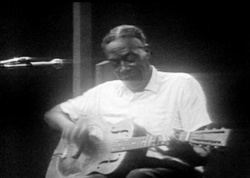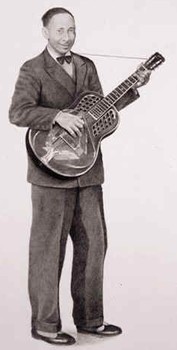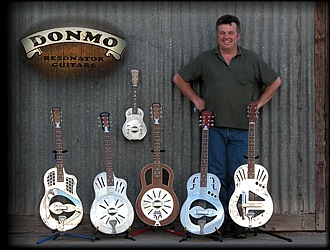|
SA
Roots 'n Blues delves into
THE HISTORY OF THE BLUES SLIDE GUITAR
THE
GUITAR
One of the most influential musical instruments of the 20th century has been
the guitar. This six-stringed instrument has played a major role in folk, blues,
country, jazz and rock and roll. There
is one guitar however that holds an extra special place in the blues and it
is the slide guitar. Just what are its origins? SA Roots & Blues decided
to investigate.
THE HAWAIIAN SLIDE GUITAR
Was it the Hawaiians? They certainly popularised this method of playing and
the Panama Canal had something to do with it. On February 20th, 1915, the Panama-Pacific
International Exposition opened in San Francisco for a seven-month run. Ostensibly
a celebration of the completion of the Panama Canal, it featured exhibits from
the Territory of Hawaii. The Hawaii Pavilion became the ‘hit’ of
the Exposition, offering shows featuring hulas dancers and the music of the
Royal Hawaiian Quartette, a group led by Hawaiian guitarist Keoki Awai. Several
other notable Hawaiian guitarists performed at the Exposition, including Joseph
Kekuku. It's claimed that he invented the slide guitar in 1894. Kekuku often
played with a violinist cousin and was envious of the sliding glissandos possible
on a fretless instrument. Kekuku experiment with various ways of getting a
violin-like tone on guitar by fretting with a comb, a glass, and eventually
the steel bar he made in the school shop of the Kamehameha School for Boys.
Over 13 million visitors came to the Exposition. This led to the so-called ‘Hawaiian
music craze’. A torrent of Hawaiian recordings appeared in 1916, and
some estimates suggest more Hawaiian records were sold on the mainland that
year than recordings in any other genre. By 1917, Hawaiian-style guitars were
being offered by such mail-order catalogs as Sears; the first Hawaiian guitar
method book (written by Keoki Awai) was published in 1916. Have a look at the
Gibson Lap Steel Guitar on the left, I haven't seen too many blues players
slappin' and slidin' on this sort of thing! The Hawaiian inflluence is certainly
detectable in country music but what about the blues?
THE WEST AFRICAN ONE STRING BOW
The Delta bottleneck style predates the Hawaiian music craze by a good decade!
W.C. Handy heard the bottleneck style in 1903 at the Tutwiler, Mississippi
train station: “a lean, loose-jointed Negro had commenced plunking a
guitar beside me while I slept,” Handy wrote in his 1941 autobiography,
FATHER OF THE BLUES. ”His clothes were rags; his feet peeped out of his
shoes. His face had on it some of the sadness of the ages. As he played, he
pressed a knife on the strings of the guitar in the manner popularized by Hawaiian
guitarists who used steel bars. The effect was unforgettable...the weirdest
music I had ever heard.” Handy’s encounter with Delta style slide
guitar predates the earliest known Hawaiian guitar recordings (1909 Edison
cylinders by Joseph Kekuku), and surely no touring Hawaiian troupes had made
it to Mississippi by 1903. One-string bow instruments such as the Umakweyana,
seen on the left, are common in Africa, especially the west coast and Congo
regions from which slaves were taken. The musical bow is essentially a hunting
bow; its pitch is varied in a number of ways, including sliding a hard object
(such as a stick or a knife) along its length.
THE DIDDLEY BOW
The "diddley bow" is similiar to an African one-string instrument.
It may well have been the first instrument that produced the sound of sliding
rhythm and the whines and cries of a single string that later became the distinctive
sound known today as the "Blues". It was common to the rural south
in the 1800's and was made by taking a piece of broom or cotton wire and stretching
it between two nails tied to the side of a wooden frame house, with a bottle
or "snuff can" wedged under the wire to create tension for pitch.
The string was plucked while sliding a piece of metal or glass on it to produce
notes.
Have a look at this photo of Delta Bluesman Son House slappin' and slidin'
on that distinctive metal bodied guitar! What are its origins?

THE DOBRO & THE NATIONAL GUITAR
Is it a Dobro? A National? What's the difference? George Beauchamp ( of The
National String Instrument Company) and John Dopyera ( of The Dobro Manufacturing
Company) have different and conflicting stories to tell! The Dobro is a resonator
guitar that was invented by the Dopyera Brothers in Los Angeles. In 1926 a
vaudeville musician named George Beauchamp approached John Dopyera with a problem
common to guitar players of the period: he wanted a louder guitar! Dopyera
experimented with various materials, such as pressed fibre, glass, tin and
metals. He eventually settled on a very thin, conical shaped aluminum resonator
design, used in a set of three connected with a T-bar inside an all metal body.
Dopyera used three as it mellowed the sound, as opposed to using one large
cone which was louder, but harsher in tone and with less sustain. The result
was the National Triolian.
Nationals were originally intended for Hawaiian and Jazz work but the adoption
of the instrument by blues artists contributed to the company's survival. This
wasn't Dopyera's intent, as he probably didn't even know what the Blues were.
John Dopyera stormed out of the National shop in January 1929. He
and Beauchamp had been rubbing each other the wrong way for some time. His
resignation stemmed from reservations that he had about the Triolian. Its
bridge sat in a round wooden “biscuit” mounted in the center of
a metal amplifying cone. He felt the design did not sustain well enough when
enlarged for a guitar. Beauchamp, overruled Dopyera and rushed the Triolian
into production in late 1928. This came as the last straw for John. He and
his brothers decided to split from National. They
formed the Dobro Manufacturing Company, which developed a more affordable wood
body guitar with a single cone and a spider-like bridge base. This new design
was introduced under the name DOBRO®, a combination of Dopyera and Brothers.
The Dobro trademark is now owned by Gibson.~
In 1928, Tampa Red became the first Black Blues artist to record with a steel
resonator-type guitar, which eventually became one of the classic blues instruments.
 Tampa
Red Tampa
Red
Shortly afterwards, a parade of National players followed on 78, Son House,
Bukka White, Bo Carter, Blind Boy Fuller, Walter Vincent, Peetie Wheatstraw,
Scrapper Blackwell, Bumble Bee Slim, and Black Ace.*
The rise of the electric steel guitar and the advent of metal shortages as
America tooled up for World War II ended Dobro production little over a decade
after it began. It wasn't until the folk music revival of the ’60s that
interest was rekindled and production recommenced. Interested in getting a
resonator guitar? Single or Tri cone? Wood or steel Body? Biscuit or spider
bridge? I suggest you pay Adelaide's own master luthier Don Morrison a visit
at DONMO.com and ask him.

"Whatever the worldly origins of the slide guitar, this form of playing
is best known for it's partnership with the blues. The slide playing of Robert
Johnson, Son House and Blind Willie Johnson has reached almost classical status.
It is a style that has captivated, amazed and baffled guitarists of all kinds,
and to my mind has become the most enchanting".+
Compliled by David Stoeckel
#
http://www.collectingchannel.com
* http://www.nationalguitars.com
+ http://www.acousticguitarworkshop.com
~http://www.erieartmuseum.org
^ http://www.littletobywalker.com

| 
